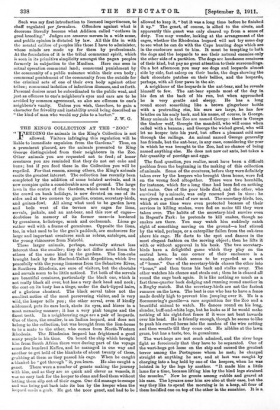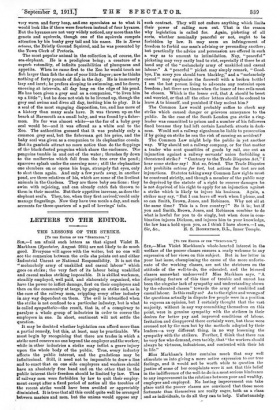THE KING'S COLLECTION AT THE "ZOO."
" FEEDING the animals in the King's Collection is not allowed. Visitors infringing this regulation will be
liable to immediate expulsion from the Gardens." Thus, on a prominent placard, are the animals presented to King George distinguished from their neighbours in the Zoo. Other animals you are requested not to feed; of lesser creatures you are reminded that they do not eat cake and buns ; but if you feed these in the Collection you will be expelled. For that reason, among others, the King's animals excite the greatest interest. The collection has recently been completed by the addition of some belated arrivals, and it now occupies quite a considerable area of ground. The large lawn in the centre of the Gardens, which used to belong to the crowd on bank holidays, is now devoted on one of its sides and at two corners to gazelles, cranes, secretary-birds, and guinea-fowl. All along what used to be garden lawn and beds west of the terrace are cages for lions, servals, jackals, and an ant-bear, and this row of cages— doubtless in memory of its former uses—is bordered by geraniums, heliotrope, musk and cockscomb. Lions go rather well with a frame of geraniums. Opposite the lions, too, in what used to be the gnu's paddock, are enclosures for large and important creatures such as zebras, antelopes, and the young rhinoceros from Nairobi.
These larger animals, perhaps, naturally attract less interest than the smaller; they do not differ much from the others of the same kind in the gardens. The lion-cubs brought back by the Macleod-Talbot Expedition, which live peacefully with the young lionesses from the Sebackwe River, in Southern Rhodesia, are sure of visitors, but the cheetahs and servals seem to be little noticed. Yet both of the servals are beautiful creatures, particularly the black one, which is not really black all over, but has a very dark head and neck ; the coat on its body has a tinge, under the dark-tipped hairs, of a glorious chestnut. The black serval takes not the smallest notice of the most persevering visitor, and is very wild, the keeper tells you ; the other serval, even if kindly addressed, puts its ears back, shuts its eyes, and hisses in a most menacing manner ; it has a very pink tongue and the finest teeth. In a neighbouring cage are a pair of leopards. One of them, the smaller, is an Indian leopard, and does not belong to the collection, but was brought from the lion-house to be a mate to the other, who comes from North-Western Rhodesia. The Rhodesian leopard has frightened a good many people in his time. On board the ship which brought him from South Africa there were during part of the voyage some five hundred Kaffirs, and he managed in one way and another to get hold of the blankets of about twenty of these, grabbing at them as they passed his cage. When he caught a blanket he "got through " it, you learn. He also caught a genet. There were a number of genets making the journey with him, and as they are as quick and clever as weasels, it was no easy task for the keeper to clean and feed them without letting them slip out of their cages. One did manage to escape and was being put back into its box by the keeper when the leopard made a grab. He got the Door genet, and had to be
allowed to keep it, " but it was a long time before he finished it up." The genet, of course, is allied to the civets, and apparently this genet was only cleared up from a sense of duty. You may wonder, looking at the arrangement of the cages, whether the Rhodesian leopard will not try some day to see what he can do with the Cape hunting dogs which are in the enclosure next to him. It must be tempting to both the dogs and the leopards to see their natural enemies only the other side of a partition. The dogs are handsome creatures of their kind, but pay no great attention to their surroundings. On a hot afternoon you may see dogs and leopards almost side by side, fast asleep on their backs, the dogs showing the dark chocolate patches on their bellies, and the leopards, perhaps, with all four paws in the air.
A neighbour of the leopards is the ant-bear, and he reveals himself to few. The ant-bear spends most of the day in his den at the back of his run, but when approached he is very gentle and sleepy. He has a long round snout something like a brown gingerbeer bottle with a protruding rim, his ears are large, he has few bristles on his scaly back, and his name, of course, is George. Many animals in the Zoo are named George : there is George the timber wolf, Georgie the mandrill, who will come when called with a banana ; and George the wicked goral, who will let no keeper into his yard, but offers a pleasant cold nose through the railings. An animal named George generally has friends, but the ant-bear, in any case, considering the year in which he was brought to the Zoo, had no chance of being named anything else. He does not now eat ants, but takes a fair quantity of porridge and eggs.
The food question, you realize, must have been a difficult problem from the beginning in the making of this collection of animals. Some of the creatures, before they were definitely taken over by the keepers who brought them home, were fed on the wrong food altogether. There were two hornbills, for instance, which for a long time had been fed on nothing but maize. One of the poor birds died, and the other, who survived by a miracle, was only rescued just in time : he was given a good meal of raw meat. The secretary-birds, too, which at one time were even protected because of their services in killing snakes, were fed on maize till they were taken over. The habits of the secretary-bird survive even in Regent's Park : he pretends to kill snakes, though no snakes are there. You may watch him suddenly catch sight of something moving on the ground—a leaf stirred by the wind, perhaps, or a caterpillar fallen from the oak-tree above his cage. He darts to the spot and dances in the most elegant fashion on the moving object ; then he lifts it with or without approval in his beak. The two secretary. birds have a delightful game which they play on the central lawn. In one corner of their enclosure is a wooden shelter which seems to be regarded as a sort of " home." One of the secretary-birds chases the other into "home," and then turns his back and stalks away. The other watches his chance and steals out ; then be is chased all round the cage back again. It is like nothing so much as a fast three-quarter back dodging and running round another in a Rugby match. But the secretary-birds are not the fastest runners on the lawn. The best is one who has to have a fence made doubly high to prevent him jumping over it. He is a Soemmering's gazelle—a rare acquisition for the Zoo and a beautiful animal to watch. He dances round on his long, slender, buff-and-white legs, but he looks as if he would make nothing of his eight-foot fence if it were not bent inwards over his bead. He is friendly enough, though be seems to like to push his curved horns into the meshes of the wire netting and then wrestle till they come out. He nibbles at the lawn grass, but has a taste, too, in geraniums.
The wart-bogs are not much admired, and the river hogs fight so ferociously that they have to be separated. One of the wart-hogs got loose on the ship and caused the greatest terror among the Portuguese whom he met; he charged straight at anything he saw, and at last was caught by charging into a bag held by one of the keepers, when ho was hoisted in by the legs by another. "It made him a little lame for a time, because lifting him by the hind legs strained the muscles." Now he grouts among rubble and gravel at his ease. The hyraxes near him are also at their ease, but the way they like to spend the morning is in a heap, all four of them huddled one on top of the other in the sunshine. It is a
very warm and furry heap, and one speculates as to what it would look like if there were fourteen instead of four hyraxes. But the hyraxes are not very widely noticed, any more than the genets and squirrels, though one of the squirrels compels attention by his bushy grey tail and his name. He is Xerus setosus, the Bristly Ground Squirrel, and he was presented by the Town Clerk of Pretoria.
The most popular animal in the collection is, of course, the sea-elephant. He is a prodigious being; a creature of a superb rotundity, of infinite possibilities of plumpness and appetite. When he came first to the Zoo he would touch no fish larger than fish the size of your little finger ; now he thinks nothing of forty pounds of fish in the day. He is immensely lazy and inert; he prefers sleeping to swimming, and be dozes, sneezing at intervals, all day long on the edge of his pond. He has been given a grey seal as a companion, "to liven him up a little "; but he does not wish to be livened up, though the grey seal swims and dives all day, inviting him to play. It is a seal of the most engaging disposition, too, and has more of a history than many seals have. It was thrown up on the beach at Barmouth as a small baby, and was found by a fisher- man. Its fur was almost white—as the fur of a baby grey seal would be—and it was offered as a white seal to the Zoo. The authorities guessed that it was probably only a common grey seal, but the fisherman got his price, and the baby seal was given as a companion to its elephantine cousin. But its gambols attract no more notice than do the floppings of the black-footed penguins which share the enclosure. The penguins tumble in and out of the water ; thrushes fly down to the mulberries which fall from the tree over the pond ; sparrows splash under the sneezing nose ; still the elephantine one slumbers on or opens his huge, strangely flat eyes, only to shut them again. And only a few yards away, in another pond, are three relatives of his, which are some of the liveliest animals in the Gardens. They are three baby sea-lions : they swim with rejoicing, and can already catch fish thrown to them in their mouths. But their appetites increase, as does the elephant seal's. They, too, when they first arrived:could only manage fingerlings. Now they have two meals a day, and each accounts for three-quarters of a pail of herrings' tails.







































 Previous page
Previous page